Complete Guide to Downhill: What it is and Where to Do it in Italy
2 maggio 2025 • 16 minutes read
•
•
•
•
•
•
What’è the downhill (or DH)
DH è the'abbreviation for “downhill”, and è a type of MTB sport in which you ride downhill along groomed mountain trails created especially narrow, with curves and various obstacles (including jumps) to make the descent challenging and fun. Literally translated from’English, “giù (down) from the hill (hill)”.
What differentiates DH from the rest of the mountain bike disciplines è precisely the descent (fast). In downhill, the ascent practically does not exist: you go up to the top of the mountain by gondola or chairlift, loading the bike on the lifts. With DH bikes, you wouldn't even be able to pedal your way to the top: they are purpose-built to make them great only on the downhill and maximize the fun side.
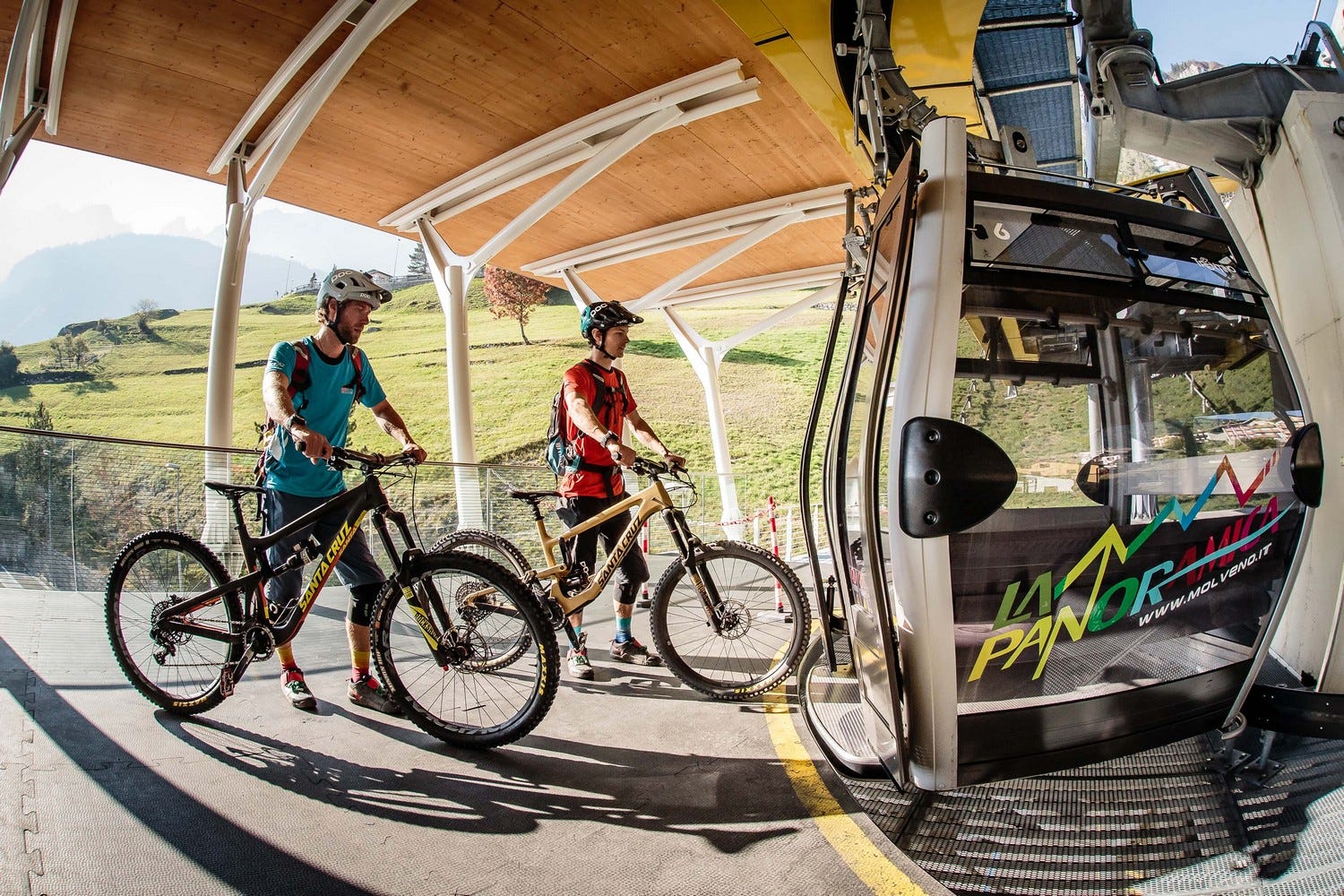 Two riders load bikes on a'gondola at Paganella Bike Park
Two riders load bikes on a'gondola at Paganella Bike ParkThe DHD bikes in fact have forks with a wide travel, so that when you take an obstacle, a pothole, land from a jump or make a fast turn going downhill, the forks can absorb the blow more — the handlebars “sink”, like a spring that contracts.
This mechanism è indispensable on the downhill to give stabilityà (otherwise for every blow you take you would fly off the bike) but it makes pedaling uphill extremely tiring, because é the forks absorb much of the effort exerted with each pedal stroke — you would struggle immensely to make even a little positive elevation gain.
Where to practice DH: what are bike parks
Since lifts are required to go up to the starts of DH trails, you can only practice downhill in those places where there are purpose-built facilities— that is, in places where there’è a bike park.
Bike park simply means the area that includes all the trails (the downhill slopes) and lifts in a certain location. As you might imagine, the first bike parks were born in mountain places when the sport did not yet attract as many people as it does now, because there were already ski lifts for skiers that could be used in the summer by bikers. There’was just a need for someone to take care of the trails (draw the trails, put in the dirt, remove the boulders, etc.).
To ride a bike downhill, there is no need to reach heights as high as those for skiing (needed instead to have snow presence in more months of the year). This fact has led, in recent years, to the’opening of bike parks even in places with lower mountains, making downhill skiing more popular and accessible to people in all regions of Italy.
Bike parks "natural"
There are areas even near the sea where DH is practiced, including very famous Finale Ligure, the "Mecca" of riders from all over Europe (and the world), and Massa Marittima. There are no real bike parks in these places. They are seaside resorts but quite mountainous inland, making them perfect for hosting downhill trails.
In addition, they are in warm places! They are ideal for DH in March, April and May or after September, when there's still snow at mountain bike parks. In DH resorts such as Finale Ligure and Massa Marittima, which do not have chairlifts and lifts, the lifts are operated by shuttles (vans), which have tied behind a bike rack to transport up to 8-9 riders at a time to the trail starts in the area.
Shuttle with bike rack for up to 8 bikers in Finale Ligure
Urban bike parks
Finally, traditional bike parks should not be confused with urban bike parks, which are instead facilities built in the cityà (and therefore on the flat) — a well-known example è the Monza Pizza Bike Park in Lombardy. They are circular trails with a succession of jumps to be done in sequence on a bike (here a video of Torquato Testa as he rides at the Monza Pizza Bike Park, of which è founder). Urban bike parks are used to practice freeride MTB or other gravity disciplines (MTB sports a bit' more “acrobatic”).
For the rest of the article we focus on "traditional", mountain bike parks, which are the ones most frequented by riders in summer.
Bike pass
As with ski resorts, bike park areas are also accessible via a pass (the “bike pass”, the sibling of the ski pass), which once purchased gives riders the opportunity to use all of the lifts multiple times during the day (bike passes are often half-day or daily). The cost for a daily bike pass is around 35€, and for a morning or afternoon around 25€.
In the bike parks you will find trails of various levels. Difficulty è è marked in color, as is the case with ski trails: blue for difficulty; low, red for difficulty; medium, and black for the most difficult trails. Below is an example with a map of the trails at the Mottolino Bike Park in Livigno (see right column).
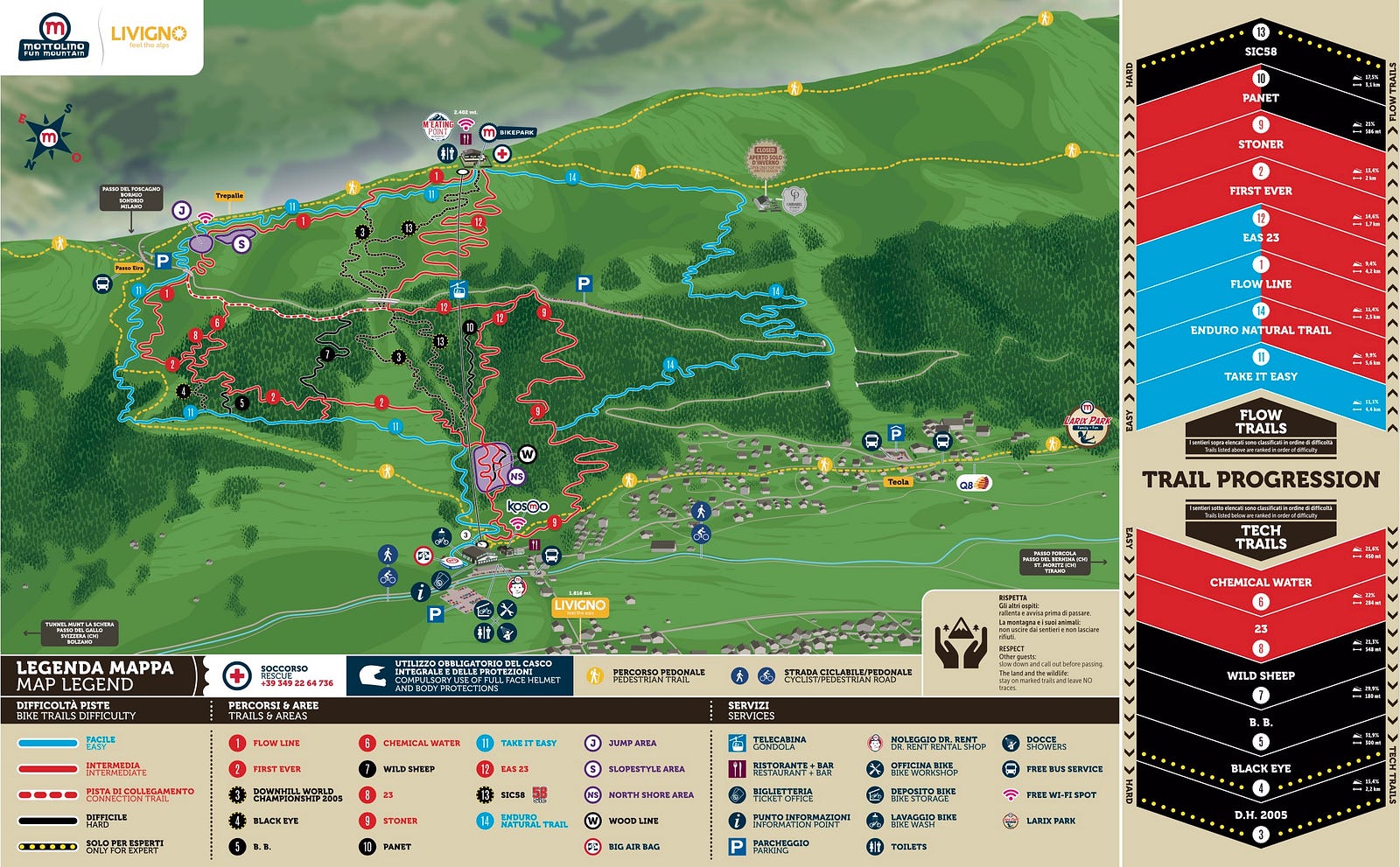 Map of the Mottolino Bike Park trails in Livigno
Map of the Mottolino Bike Park trails in LivignoWe have previously posted a list of what we think are the best bike parks in Italy.
We repost here our 3 favorites:
.1. Dolomiti Paganella Bike Park – Andalo, Trentino
Maybe the mostù beautiful for DH. The Paganella Dolomites èarea is a biker's paradise, and every year it attracts many riders of all levels to their trails. The bike area of the Dolomiti Paganella è very large, and there are lifts that connect trails between 3 neighboring towns: Andalo, Molveno and Fai della Paganella.
From any of the three you can start and fully explore the area without ever getting off your bike (except to take the chairlifts) and without ever doing the same trail twice! Most famous and beautiful to ride are the Bear Trails, somewhat challenging in difficulty, for the creation of which you have to thank various contributors including the legendary Steve Ude (Stefano Udeschini).
An’other great thing about the Paganella Dolomites bike park is the resources it provides you with online to learn about the area: you can’explore it almost completely from home. They have a beautiful map 3D with all the routes indicated — you can see it at this link — and also all the trails maps that you can download as a pdf version.
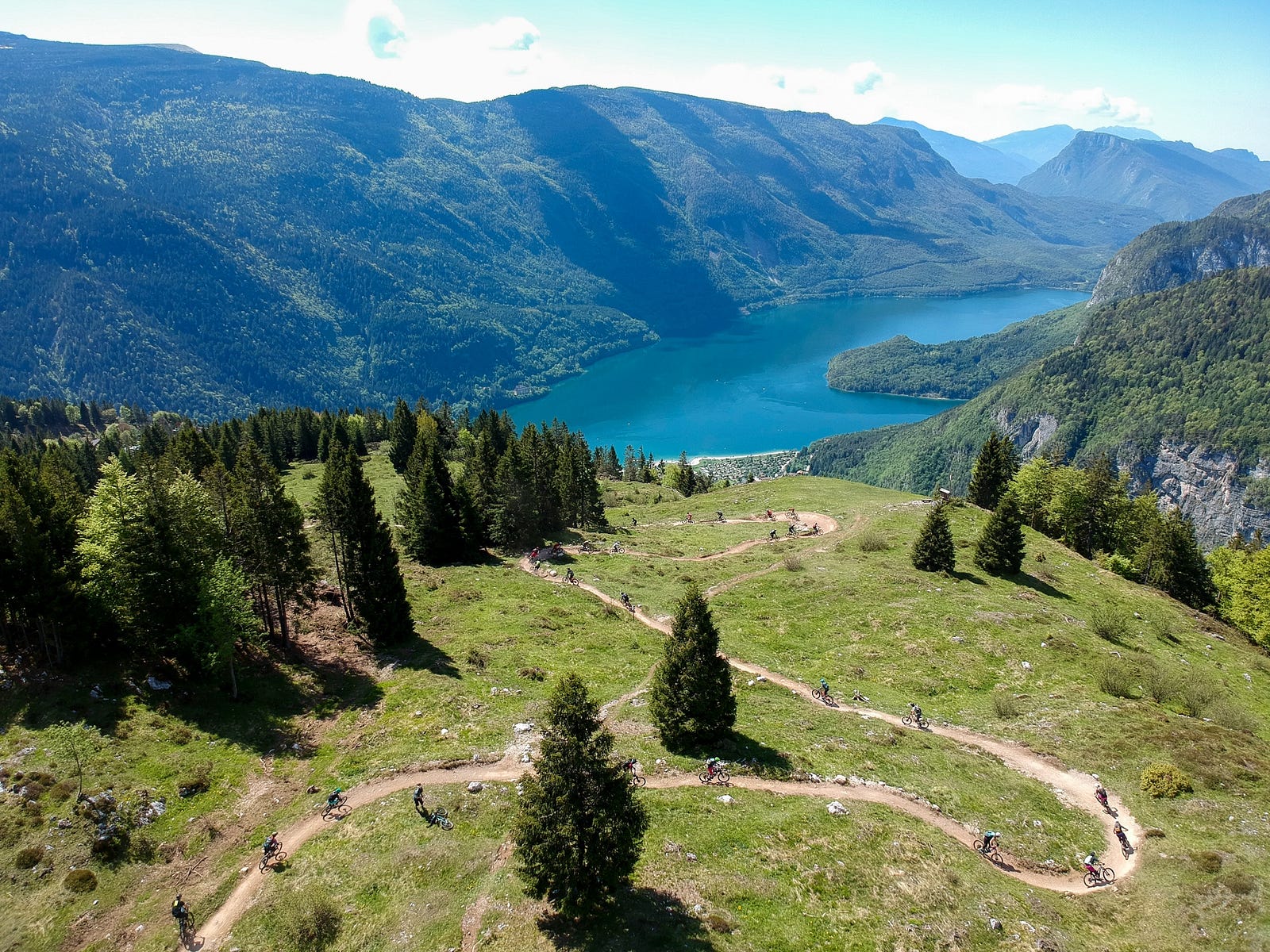 Trail “Big Hero” of the Paganella Dolomites Bike Park
Trail “Big Hero” of the Paganella Dolomites Bike Park2. Mottolino Bike Park – Livigno, Lombardy
In Livigno, the Mottolino è the mostù famous of the 2 bike parks there (the second è the Carosello Mountain Park). È the best in Italy for what concerns fun (the mountain, not coincidentally, è also called Mottolino Fun Mountain for the presence of the bike park in summer and the snow park in winter, both very famous), with steep and fun trails full of curves and a’jump area perfect for those who practice freeride MTB.
The Mottolino Bike Park è where, in fact, Gravity classes in MTB downhill and jumps are practiced. Holidoit collaborates with the official guides of Livigno to give you the opportunity to book a course or downhill lesson during the Livigno summer. You canò start DH at Carosello as well, where the trails are smoother and a bit’ less difficult.
 Riders at the start of the Mottolino Bike Park in Livigno
Riders at the start of the Mottolino Bike Park in Livigno3. Pila Bike Park – Pila, Valle d'Aosta
That of Pila è the most famous bike park in Valle d’Aosta. È very big, and you can’ do a little bit of everything: from pure downhill to riding trails in the surrounding mountains, more enduro MTB style (more on the enduro topic later).
In Pila, Aosta Valley Freeride is organizing a course over two days to approach downhill, with lessons in the morning and riding independently in the afternoon. È everything included (bike pass, transfer, downhill bike), except for the ’accommodation that you have to take in Aosta on your own. If interested, we recommend you check it out.
.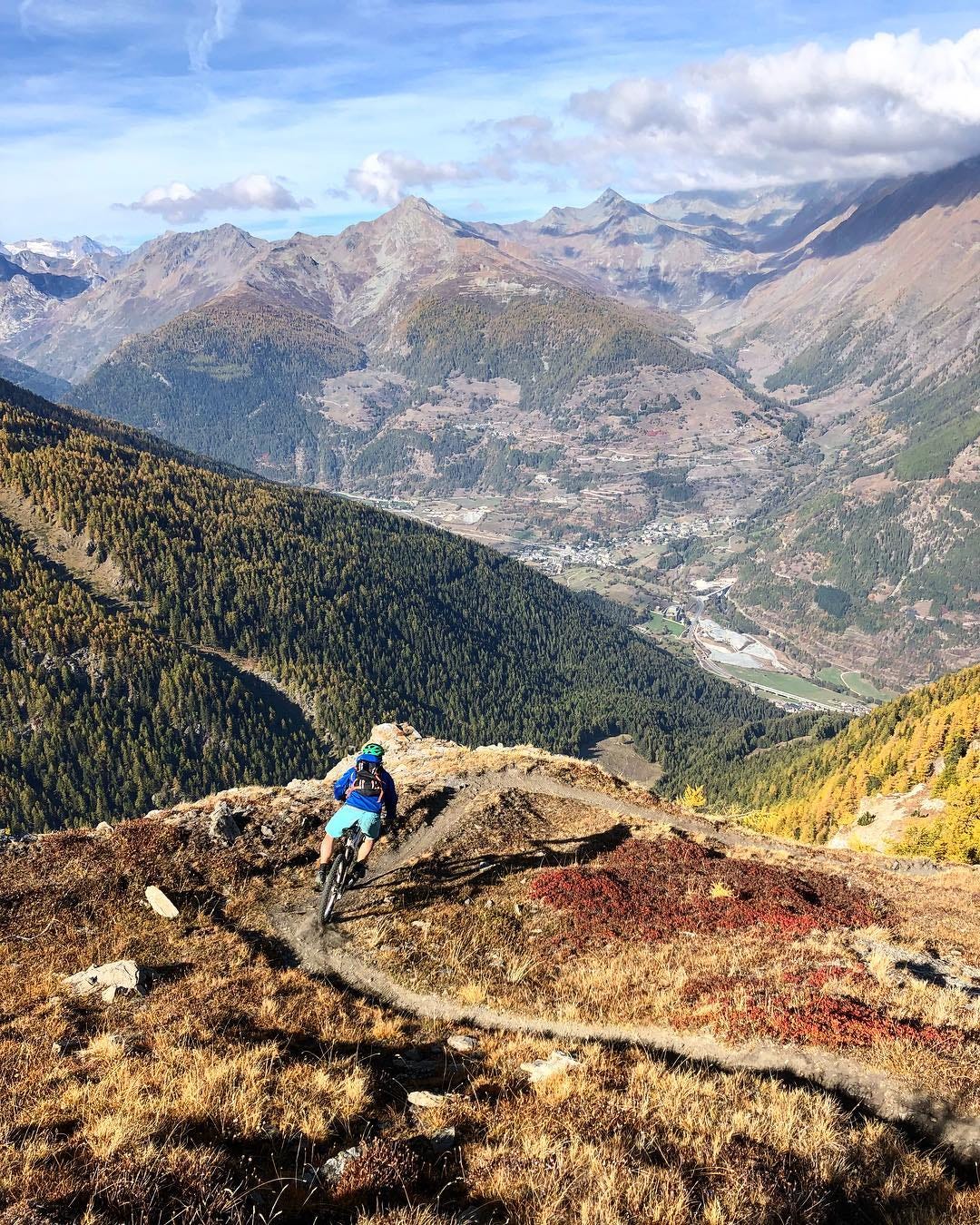 A trail at the Pila bike park
A trail at the Pila bike parkHow to start Downhill
Downhill è a fairly technical sport – and so you have to learn a bit’ the basic techniques to get started. There are four ways to learn:
.- Individual lessons or courses
- Bike Camp
- Following a friend who does downhill (and knows the technique) .
- Self-taught (seeing videos on Youtube)
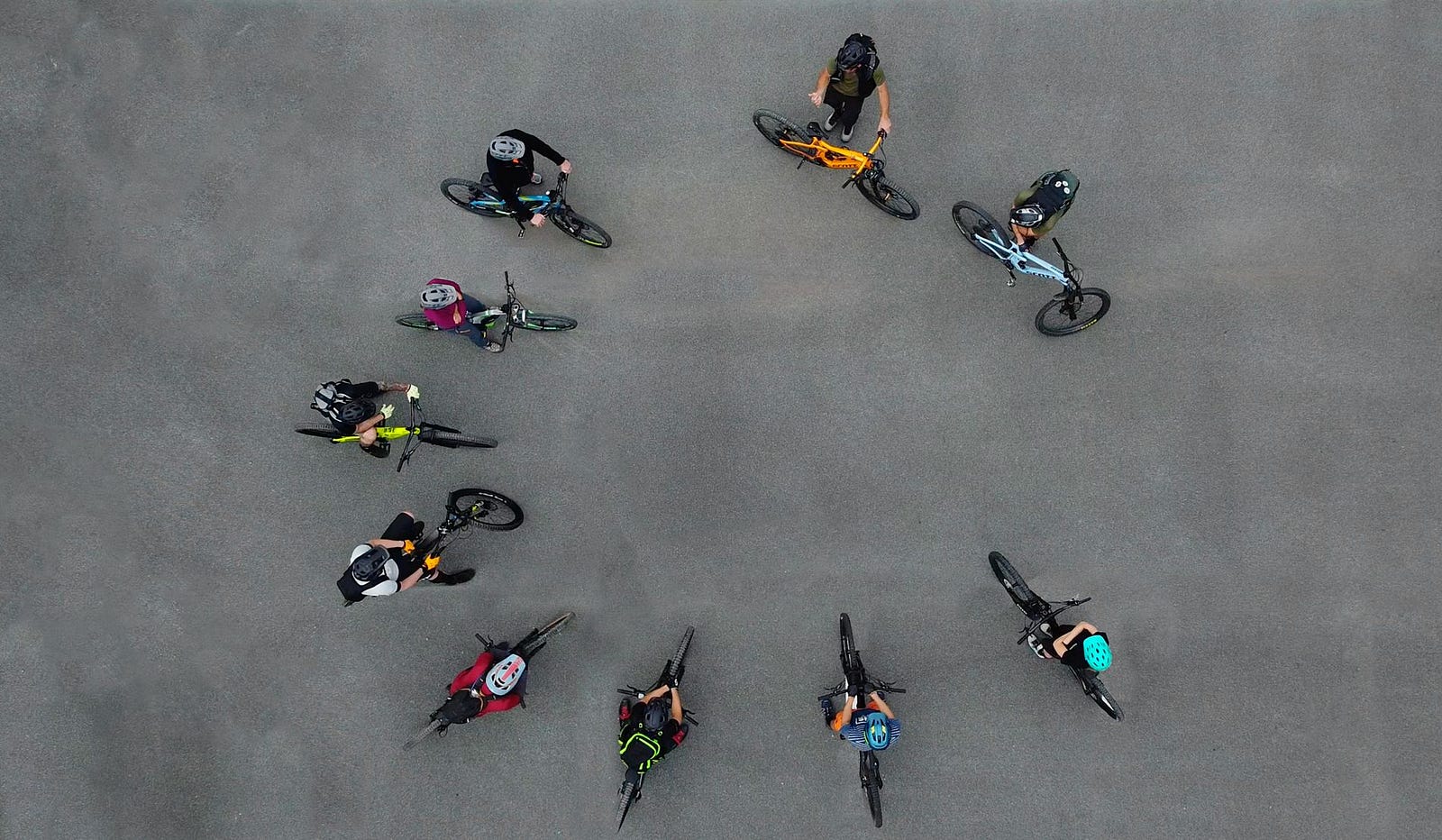 Bike Camp organized by Aosta Valley Freeride
Bike Camp organized by Aosta Valley FreerideBike camp
.All but the fourth are very effective methods; doing a camp è perhaps the most youth-friendly way to learn (they typically participate in camp kids ages 12 to 18 or younger, but camps are often organized for older kids as well), because it provides a few days of full-immersion and allows them to learn basic techniques in a short time. È definitely the most fun way, especially for boys or girls.
DH Lessons
Individual lessons or classes are perfect for those who are just starting out and want to improve and advance their technique from week to week. You are joined during the morning by an instructor who takes you around the bike park, giving you the tips and support you need. Support è the key word: you need to be followed and correct your technique mistakes through an iterative process; the instructor has an outside perspective on your MTB riding, notices your mistakes more easily, and can give you (the right) pointers to improve.
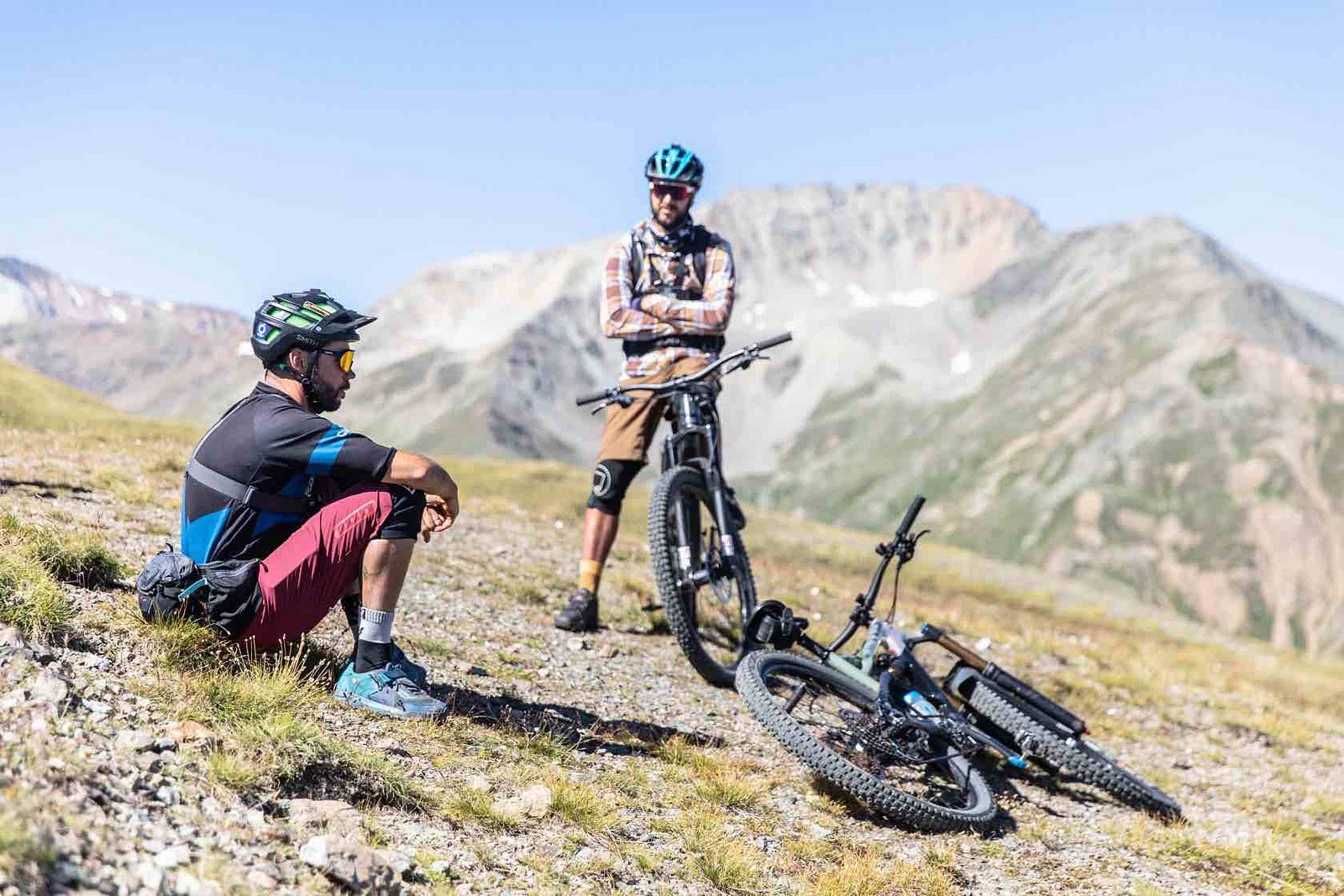 Downhill lesson at Carosello Mountain Park in Livigno
Downhill lesson at Carosello Mountain Park in Livignoflank-a-friend
Learning through a friend è perhaps the most effective way to get you out of the house and onto the slopes — è a way we really like. Foré you to learn well, però your friend must also know how to communicate to you what to do and have the patience to follow you a bit’. Sometimes it canò be difficult even for a professional. È good to try this technique after a couple of lessons, in which maybe you get to know some other local riders to go down with the next times.
Self-taught
We don't particularly recommend the self-taught route; the risk è of wasting a lot of time, making little progress, and not even having fun! Ask yourself this: è is it better to take 2 lessons, learn the basic techniques well enough and then be able to go down independently (more or less well) from the third outing onwards, or to go 10 times alone and at the eleventh find yourself still more or less where you started? For us, the answer è the first option.
Lessons or a DH camp are a great initial investment (they save you money later and let you enjoy the money spent on bike passes and rentals).
Downhill bikes and DH equipment
Let's get to the’equipment needed to practice DH. If you are a beginner or want to approach downhill, you don’t need to worry about it much for the time being. Also, if you book a lesson or course, the bike and protections will be able to pick them out for you by the guide and he will explain how to use them.
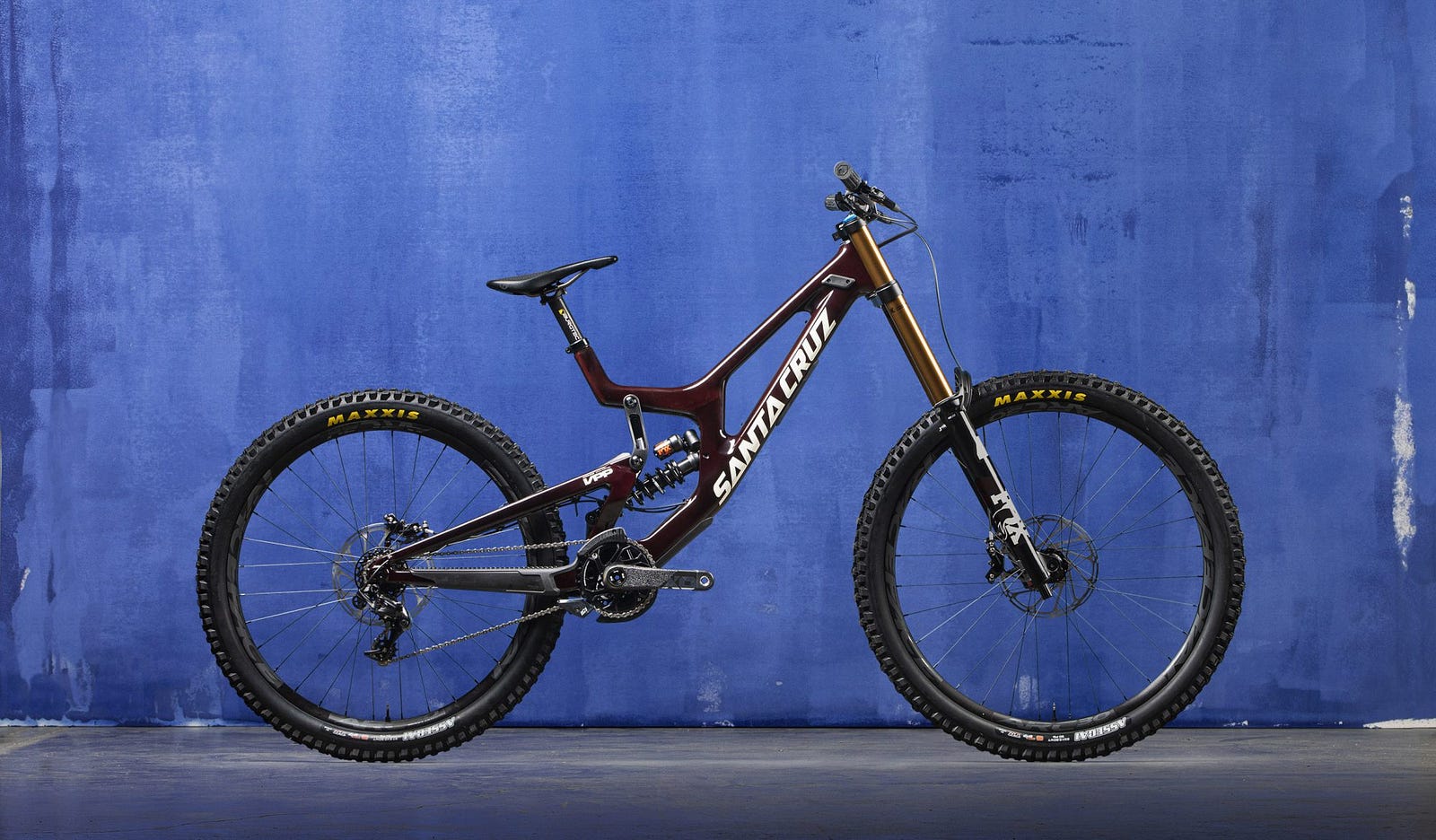 Santa Cruz v10, one of the mostù popular DH bikes
Santa Cruz v10, one of the mostù popular DH bikesFeatures of the downhill bike
The main things to know about downhill bikes are these:
- Frame: a “V”, they have a slanted shape to provide better stability; è the piece that costs the most in a DH bike, and also the most important; the price varies depending on the material it è made of (light and hard/durable materials, such as carbon or aluminum, are awarded);
- Weight: these MTBs are usually lighter than the others, weighing around 15–16kg for better maneuverabilityà downhill;
- Wheels: 27.5- or 29-inch, and the tires are the tapered MTB tires for the dirt terrain of bike park trails;
- Damping: the most distinctive thing about DH bikes, which have forks and the rear shock with long travel (i.e., you can contract them a lot, like springs), around 200mm or more (about a span);
- Brakes: disc brakes front and rear, perforce, and better if the disc è wide —this type of brakes are much better than traditional drum brakes and provide more safety;
- Cost: from about 1200€ upwards, up to 7000€+ for super-top-of-the-line bikes and with the highest quality materials and individual parts;
There are other features to pay attention to, but in general they are the ones above the “deal-breakers” that is, the mostù decisive ones that can make people choose one bike over another.
If you are choosing a DH bike and need some’ inspiration, this article maybe canò help. In general, we suggest you get recommendations from two or three professional riders you trust (these can also be guides from bike parks you've been to, or Youtubers who aren't sponsoring products — below we recommend a few to follow). You can then choose the one you like best (also of aesthetic!).
protections-and-helmet
The rest of the DH equipment è the following:
.- Suit (DH shorts and sweater) .
- Helmet
- Knee pads
- Ebow pads
- Gloves
- Shoes
Usually, downhill bike rentals give you the opportunity to reserve all the kit at a moderate cost (around 20€ per day or so, even less if you rent them together with the bike).
Who-to-follow-on-youtube-for-enthusiast-of DH
Here are some Italian Youtubers we really like and recommend you to follow:
- DieMTB – Diego Caverzasi, è an athlete from Livigno, cracks up with laughter and è rocks. È the most ù on topic for DH. .
- Torquato Testa – beautiful videos, lots of jumps with dirt bikes (and in minimoto at times 😄). È a pro at jumping. His specialty è è gravity but of course he also does downhill and bike park videos (he also has a dedicated playlist). Follow him, è the top in Italy. .
- Andrea Ziliani – Great MTB and E-bikes reviewer. If you have to choose a bike, listen to him: he knows everything about all the parts of all the brands, and he explains it to you until you know it too.
- Erwin Ronzon – Strong Enduro MTB pro rider, races and rides like lightning. Perfect for those who è also interested in Enduro, a discipline similar to DH (we briefly explain the difference below).
Downhill or Enduro MTB?
Enduro’enduro è a somewhat different way of riding MTB than DH, because’it combines uphill and downhill sections. This makes the MTB experience a bit more complete. Having an enduro bike è much less limiting than having a downhill bike: with the latter you can only go in bike parks; with the enduro bike you can go…more or less everywhere (even in bike parks).
The ’latest evolution è the enduro E-MTB, made with electric bike. È the top becauseé pedaled climbs become enjoyable and not exhausting, and are accessible to many more people. What's more, with electric you can do much longer rides than with the regular enduro bike (called “muscular” because é there’è is no electric motor to do the fatigue for you, and you can only use your muscles to keep going 😄).
 Two riders do an Enduro MTB tour in Livigno
Two riders do an Enduro MTB tour in LivignoTo sum up: if with the downhill bike you can only move “vertically” in the mountains, moreover only downhill, with the enduro bike you can move both vertically (but both downhill and uphill) and horizontally, riding more or less long trails in the surrounding mountains. The Enduro E-MTB è even better because you can move farther, in less time and faster.
Enduro MTB and E-MTB are topics worth tackling separately. Stay tuned for suggestions of beautiful routes to take that we will post on the blog 🌟.
Good riding!
Find Holidoit on:
Related articles

The best 8 mountain destinations in Lombardy, a comprehensive article that will help you choose your ideal mountain in L...

A ranking of the best bike parks in Italy. The 3 most popular areas for enduro and DH. Finally, a list of bike parks bro...

A selection of easy and intermediate MTB trails in Livigno, nice for families and also with friends. They can be done ei...

Here are the 10 best treks in Lombardy to do in the day...










